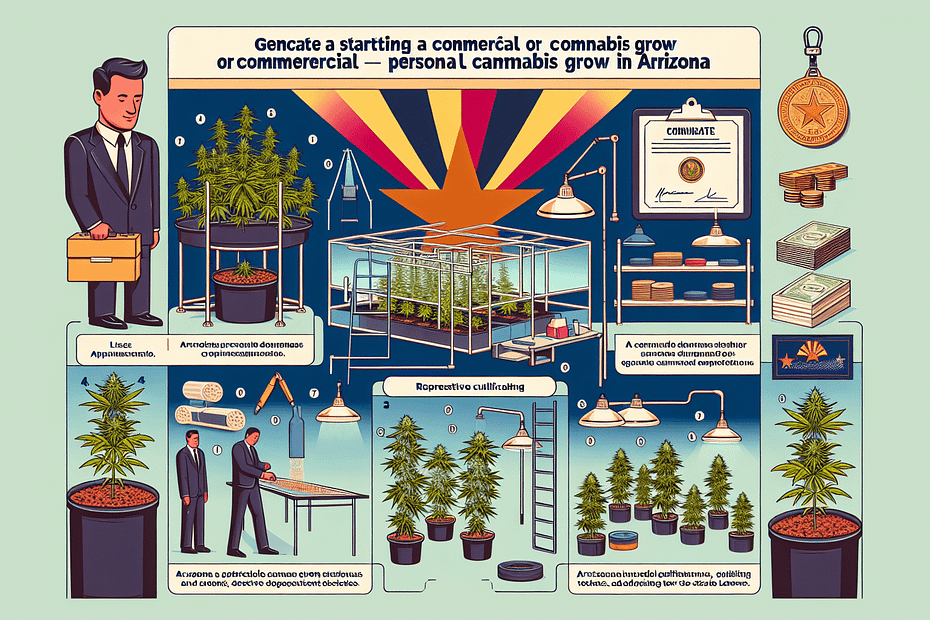So you’re interested in starting a commercial or personal grow in Arizona? Well, you’ve come to the right place! In this article, we’ll walk you through the essential steps and considerations you need to make to turn your green thumb into a successful venture. Whether you’re looking to cultivate cannabis for business purposes or simply want to grow your own plants at home, Arizona offers a promising landscape for growers. From understanding the legal requirements to setting up the right infrastructure, we’ve got you covered. So get ready to dig in and start your journey into the world of growing in Arizona!
Understanding the Legal Requirements
Before starting a commercial or personal grow operation in Arizona, it is crucial to understand the legal requirements. Researching the laws and regulations surrounding cannabis cultivation is the first step in this process. Familiarize yourself with the specific rules and restrictions set forth by the state and local authorities.
Obtaining the necessary licenses and permits is another essential aspect of compliance. Depending on the scale and nature of your operation, different licenses may be required. To avoid any legal issues, it is important to thoroughly review the licensing requirements and submit the appropriate applications.
Complying with zoning regulations is also a crucial element. Different areas in Arizona may have specific zoning restrictions for cannabis cultivation. Ensure that you choose a location that is designated for such operations and meets all the necessary zoning requirements.
Understanding the taxation and reporting obligations is equally important. As a cannabis cultivator, you will have various tax obligations, such as sales tax and excise tax. Familiarize yourself with the tax laws and reporting requirements to avoid any penalties or legal troubles down the line.
Determining the Type of Grow Operation
Once you have a clear understanding of the legal requirements, it’s time to determine the type of grow operation you want to establish. This decision will have a significant impact on various aspects of your cultivation journey.
Distinguishing between commercial and personal grows is an important consideration. Are you planning to cultivate cannabis for personal use or are you looking to establish a commercial operation? Commercial grows are subject to additional regulations and licensing requirements, so be sure to understand the implications of each option.
Choosing between indoor, outdoor, or greenhouse cultivation is another decision to make. Each method has its own advantages and disadvantages. Indoor cultivation provides greater control over the environment but may lead to higher energy costs. Outdoor cultivation, on the other hand, relies on natural sunlight but is subject to seasonal limitations. Greenhouse cultivation offers a balance between the two options, providing controlled conditions while utilizing natural light.
Deciding on the cultivation method is equally important. Whether you choose soil, hydroponics, or another method, it will impact factors such as water usage, nutrient delivery, and overall plant health. Consider the pros and cons of each method and choose the one that best aligns with your goals and resources.
Understanding the pros and cons of different grow sizes is essential. The size of your operation will determine the level of investment required, the amount of cannabis you can produce, and the complexity of running your business. Evaluate your resources, goals, and market demand before deciding on the appropriate grow size.
Securing Adequate Finances
Starting and running a grow operation requires a significant amount of financial investment. Securing adequate finances is crucial to ensure the success and sustainability of your business.
Creating a detailed business plan is the first step in securing finances. Your business plan should outline your goals, financial projections, market analysis, and strategies for growth. A well-developed business plan will not only help you secure funding but also serve as a roadmap for your operation.
Seeking financial investment or loans is another option. Consider approaching investors who are interested in the cannabis industry or apply for loans from banks or credit unions. Present your business plan and demonstrate the potential profitability and viability of your operation to secure the necessary funds.
Budgeting for startup costs and ongoing expenses is essential. Determine the costs associated with acquiring property, equipment, seeds, licenses, and more. Additionally, take into account the ongoing expenses such as utilities, labor, cultivation supplies, marketing, and compliance costs. Thoroughly estimate these costs to ensure you have sufficient funds to cover them.
Considering inventory and equipment costs is another financial factor to keep in mind. Depending on the scale of your operation, you may need to invest in equipment such as lights, HVAC systems, irrigation systems, and cultivation tools. Similarly, factor in the costs of acquiring quality genetics and seeds for your cultivation.
Finding Suitable Property and Facilities
Finding suitable property and facilities is crucial for a successful grow operation. Here are some factors to consider when searching for the perfect location.
Identify a location with a favorable climate and accessibility. Cannabis cultivation requires specific environmental conditions, so choose a location with a suitable climate and access to water. Consider factors such as temperature, humidity, rainfall, and sunlight when selecting your property.
Ensure proper security measures are in place. Cannabis cultivation can attract unwanted attention, so it is crucial to prioritize security. Look for properties with adequate fencing, surveillance systems, and controlled access points. Implementing security measures will not only protect your crop but also help you comply with regulatory requirements.
Check for adequate space and layout. Evaluate the available space and determine if it is sufficient for your desired grow size. Consider factors such as the number of plants you plan to cultivate, the layout for different stages of plant growth, and the workspace required for your staff.
Evaluate utility infrastructure and requirements. Ensure that the property has access to reliable electricity, water, and internet connectivity. Cultivation operations have high energy demands, so confirming that the property can support your electrical needs is crucial. Additionally, consider the availability of water sources for irrigation.
Sourcing Quality Genetics and Seeds
The success of your cultivation operation relies heavily on the quality of genetics and seeds you choose. Here are some tips to help you make informed decisions in this area.
Research different strains and genetics. There are countless cannabis strains available, each with its own unique characteristics. Familiarize yourself with different strains and their effects to determine which ones align with your desired outcomes.
Identify reputable seed banks or breeders. It’s important to source genetics and seeds from reputable suppliers to ensure quality and reliability. Look for well-established seed banks or breeders with positive reviews and a track record of producing high-quality genetics.
Understand seed germination and selection. Proper germination is crucial for successful cannabis cultivation. Learn about the different germination methods and choose the one that suits your needs. Additionally, carefully inspect and select seeds that exhibit desirable traits such as size, color, and texture.
Consider genetics for desired effects and yield. Different strains offer varying levels of cannabinoids, terpenes, and desired effects. Consider your target market and the desired effects you want to offer when choosing genetics. Additionally, consider the yield potential of different strains to ensure you meet your production goals.
Setting Up the Cultivation Environment
Creating an optimal growing space is essential to maximize the potential of your cannabis plants. Here are some key considerations when setting up the cultivation environment.
Create an optimal growing space. Ensure that your cultivation space provides adequate room for plant growth and easy accessibility. Consider factors such as vertical height, aisle width, and overall layout to maximize space utilization and workflow efficiency.
Install lighting, ventilation, and temperature control systems. Cannabis plants require specific light cycles and intensity levels for healthy growth. Install the appropriate lighting systems, such as high-intensity discharge (HID) lights or light-emitting diodes (LEDs). Additionally, ensure proper ventilation and temperature control systems to maintain a consistent and optimal environment.
Choose the suitable growing medium and fertilizers. Selecting the right growing medium is crucial for proper nutrient absorption and root development. Options include soil, coco coir, rockwool, or hydroponic systems. Choose the medium that aligns with your cultivation method and provides the necessary nutrients for your plants. Additionally, ensure you have access to quality fertilizers and feed for different stages of plant growth.
Implement pest control and disease prevention measures. Cannabis plants are susceptible to pests and diseases, which can significantly impact yield and quality. Implement integrated pest management (IPM) techniques to prevent and control pests. Regularly monitor your plants for signs of infestation or disease and take appropriate measures to minimize the risk.
Developing a Cultivation Schedule and Techniques
Understanding the plant life cycle and developing a cultivation schedule is essential for successful cannabis cultivation. Here are some key elements to consider.
Understand the plant life cycle. Cannabis plants go through different growth stages, including seedling, vegetative, and flowering stages. Familiarize yourself with the timeframes and requirements of each stage to ensure optimal plant development.
Establish propagation and vegetation methods. Propagation involves the creation of clones from mother plants, while vegetation refers to the growth stage before flowering. Choose the propagation method that suits your needs, such as using rooting hormone or aeroponic cloning systems. Similarly, establish vegetation techniques such as topping, pruning, or training to shape plant structure and promote growth.
Master pruning, training, and defoliation techniques. Pruning and training techniques help optimize plant growth, shape, and yield. Learn about different pruning methods such as topping, lollipopping, or defoliation to maintain an optimal canopy and increase light penetration.
Implement feeding and nutrient schedules. Cannabis plants require specific nutrients at different stages of growth. Develop a feeding schedule that provides the necessary macro and micronutrients for each growth phase. Monitor plant health and adjust nutrient levels accordingly to ensure proper development.
Monitoring and Maintaining Plant Health
Maintaining the health and wellbeing of your cannabis plants is crucial for a successful harvest. Here are some important practices to keep in mind.
Regularly inspect for pests, diseases, and deficiencies. Conduct routine inspections of your plants to detect any signs of pests, diseases, or nutrient deficiencies. Early detection and intervention can prevent widespread problems and ensure the overall health of your crop.
Monitor environmental factors such as humidity and pH. Cannabis plants have specific environmental requirements for optimal growth. Regularly monitor factors such as humidity, temperature, and pH levels to ensure they are within the desired range.
Implement watering and irrigation systems. Proper watering techniques are crucial for healthy plant growth. Establish an irrigation system that provides consistent and adequate moisture to the plants. Monitor soil moisture levels and adjust watering frequency and duration as needed.
Use integrated pest management approaches. Integrated pest management techniques involve a combination of preventive and responsive measures to control pests. Implement practices such as beneficial insects, organic pesticides, and physical barriers to minimize the risk of infestations.
Harvesting, Drying & Curing Techniques
Knowing the optimal time to harvest and mastering the techniques for drying and curing your cannabis buds is essential for achieving the desired quality. Here are some key considerations.
Determine the optimal harvest time. Harvesting too early or too late can significantly impact the potency and flavor of your cannabis buds. Monitor trichome development using a magnifying tool to determine the ideal time for harvest.
Use proper techniques for cutting, trimming, and handling. Once harvested, it’s important to handle the plants with care to preserve the trichomes and overall quality. Use clean and sharp tools for cutting and trimming, taking care not to damage the buds in the process.
Dry cannabis buds to achieve desired quality. Proper drying is crucial to preserve the flavor, potency, and overall quality of your buds. Hang the trimmed buds in a cool, dark, and well-ventilated space with proper airflow. Monitor humidity levels and ensure the buds are fully dried before moving to the next stage.
Cure cannabis buds for enhanced flavor and potency. Curing involves placing the dried buds in a controlled environment with specific humidity and temperature levels. This process allows the buds to slowly release moisture and develop desired flavors and aromas. Store the cured buds in airtight containers to maintain their quality.
Navigating Compliance and Testing Procedures
Compliance and testing procedures play a vital role in the cannabis industry. Understanding and adhering to these requirements is essential to ensure your operation operates legally and offers high-quality products. Here are some key considerations.
Understand state testing and quality control requirements. Different states have specific requirements for testing cannabis products to ensure safety and quality. Familiarize yourself with the testing protocols, including cannabinoid profile testing, potency analysis, pesticide screening, and microbial testing.
Comply with product packaging and labeling regulations. Proper product packaging and labeling are essential for compliance and consumer safety. Ensure that your products are packaged according to the state regulations, including child-resistant packaging. Clearly label the products with accurate information on potency, ingredients, warnings, and other required details.
Ensure accurate record-keeping and reporting. Maintaining accurate records is crucial for compliance and transparency. Keep detailed records of your cultivation processes, including plant counts, cultivation methods, pesticide usage, and any other relevant information. Additionally, ensure timely and accurate reporting to the appropriate regulatory bodies.
Prepare for inspections and audits. Regulatory authorities may conduct regular inspections and audits to ensure compliance. Be prepared for these visits by maintaining organized records, addressing any compliance issues promptly, and implementing corrective actions as needed.
Starting a commercial or personal grow operation in Arizona requires a comprehensive understanding of the legal requirements, careful planning, and diligent execution. By researching the laws, determining the type of grow operation, securing adequate finances, finding suitable property, sourcing quality genetics, setting up the cultivation environment, developing a cultivation schedule, monitoring plant health, implementing proper harvesting and curing techniques, and navigating compliance and testing procedures, you can set yourself up for success in the cannabis industry. Remember to stay informed, adapt to the evolving regulations, and prioritize the health and quality of your plants throughout the cultivation process.




